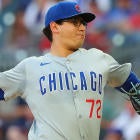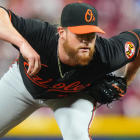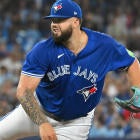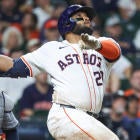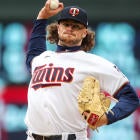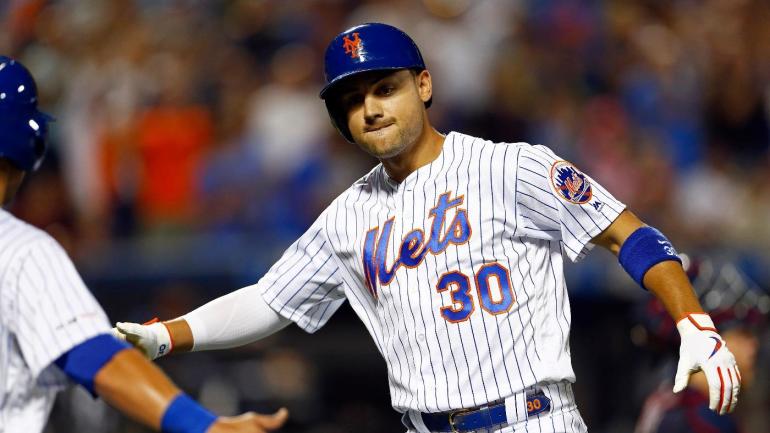
As we get deeper into the second month of the Fantasy Baseball season, we're noticing some trends that are sustainable and others that are not so sustainable. For the early part of this 2021 season, it seemed like we were headed toward a new version of baseball where hitters struck out a lot more frequently with a lot fewer hits. That, however, may start to be normalizing. As Scott White noted on Sunday, league-wide BABIP in April 2021 was .283 while in May of 2021 it was .293 and in all of 2020 it was .292. In addition to that, league-wide strikeout percentage in April 2021 was 24.4% while in May 2021 it was 23.4% and in all of 2020 it was 23.4%. League-wide batting average in April 2021 was .232 while in May 2021 it was .242 and all of 2020 it was .245.
To kick off each week of the season, I'll be reaching out to Fantasy Baseball Today's Scott White and Frank Stampfl to ask them a few big questions that can hopefully help lead to actionable advice.
1. Who is the next must-add prospect we'll see come up?
- Scott: Wander Franco feels like the only acceptable answer here. Granted, he's one of several prospects who I feel like could be up any day now, but of that group, he's the only one who I think would be an automatic add, regardless of league size or need. Of course, seeing as he's currently rostered in 76 percent of CBS Sports leagues, it's possible he's beyond adding already, in which case I would suggest future Red Sox center fielder Jarren Duran, whose power breakthrough this spring has continued at Triple-A.
- Chris: It could be Alek Manoah, given the Blue Jays need in the rotation, but I'll go with Jo Adell. The Angels have been running Taylor Ward and his career .211/.279/.356 line at right field since moving Jared Walsh to first and releasing Albert Pujols, so there's clearly room for Adell. He is still striking out a lot (15 in nine games at Triple-A), but he also has four homers and two steals. He could be an impact option in Roto leagues with that skill set, and Adell is still just 22 years old. Brandon Marsh is right there with him in Triple-A and could get the call instead, but Adell looks like the better prospect and the more interesting Fantasy option. I'm still stashing Adell.
- Frank: Let's go with Blue Jays pitching prospect Alek Manoah, former first round pick in 2019. Manoah only has eight starts in his minor-league career but they've been really strong. Specifically this season he's pitched 12 shutout innings with 17 strikeouts to just two walks. The Blue Jays could use him, too, as their starter pitchers have a collective 4.42 ERA this season, which ranks 18th in baseball. Manoah is currently available in about 70% of CBS leagues.
2. Which batter is most likely to experience positive regression rest of season?
- Scott: There are too many candidates to count, but one of the likeliest to me is Michael Conforto. By most any metric, he looks like fundamentally the same player he was last year. He's hitting the ball at about the same average exit velocity, with the same average launch angle and hard-hit rate. His xBA (.275) and xSLG (.473) are also about what they were in 2020 (.285 and .482). He was never going to repeat last year's .322 batting average, which relied on a .412 BABIP, but I'd expect him to hit about .280 with a 25-to-30-homer pace the rest of the way.
- Chris: This one might be too obvious, but Juan Soto is too good to hit like this all season. He has a .264/.393/.391 line for the season, but if you check under the hood, he looks a lot like the guy he's always been, with one of the largest gaps between his xwOBA and his actual wOBA among all hitters. He's hitting too many balls on the ground, but that's more like a minor hindrance than something to actually be worried about. I doubt anyone would actually be willing to sell Soto for even 95 cents on the dollar, but if you could get him, I would do it.
- Frank: One of the biggest underachievers in terms of wOBA vs. expected wOBA this season is Juan Soto. He's currently batting .264 with a .391 slugging percentage. Based on his quality of contact, Statcast says Soto has deserved a .312 batting average with a .562 slugging percentage. The problem here is it will likely be too difficult to try and acquire Soto. Somebody you might be able to get for cheaper who will positively regress is Francisco Lindor. I know he was disappointing last season as well but simply put, he is just too skilled to be batting .190 with a .582 OPS right now.
We break down other struggling players and what to do with them including Lucas Giolito on the latest Fantasy Baseball Today podcast. You can subscribe to make sure you get the latest episodes when they drop on Apple and Spotify.
3. Which batter is most likely to experience negative regression rest of season?
- Scott: A four-homer week has brought Mitch Haniger's season total up to 12, putting up there with Aaron Judge and Ronald Acuna for the major-league lead, when that's just not the kind of player he is. He's already nearly halfway to his career high of 26 homers, achieved during his one healthy season, and there's nothing in the underlying numbers to suggest he's unlocked some latent ability at age 30. He's a fine hitter who will reach base at a good clip and avoid prolonged slumps, but the home run pace will slow considerably from here.
- Chris: I think there might be a sense that Jared Walsh has made a leap to superstardom, when the reality is he's more likely to be a merely good hitter moving forward. There's nothing wrong with that, obviously, but he's playing well over his head right now -- a .409 BABIP being the obvious example of how. I buy Walsh as a must-start option at either first base or especially outfield, but I I think he's a lot more likely to hit .250 than to stay near his current .338 mark.
- Frank: This one pains me to say because I was a pretty big fan coming into the season, but Dylan Carlson is due for some regression. He's currently batting .281 but that's been propped up by a .371 BABIP. While Carlson has a 24% line drive rate, his 28.9% hard hit rate ranks in the bottom 7% in baseball. Statcast says Carlson has deserved a .230 batting average to this point.
4. Which pitcher is most likely to experience positive regression rest of season?
- Scott: Even though he delivered a quality start in five of his first six attempts, somehow Dylan Bundy's ERA is over 6.00 now. Just by virtue of his 3.84 xFIP and 3.53 xERA, I wouldn't expect it to last, but when I look at the numbers, I see a lot of the same qualities that led to a 3.29 ERA in 2020. I think it's fair to deduce he had some good home run luck that year and that maybe the mid-threes range is a fairer estimate for his ERA, but the bottom line is he's throwing his fastball almost 2 mph harder this year and has a better spin rate on everything. He'll settle back down.
- Chris: It has to be Luis Castillo. He's been awful so far, there's no doubt about, and there really isn't a great explanation for it. His changeup hasn't been nearly as effective as in year's past, and he's struggled to put hitters away as a result, but he's been too good for too long not to turn this around. He's still in my top-15 for the rest of the season, and I'm buying him wherever I can.
- Frank: Say what you want about the guy right now, but Luis Castillo is better than a 7.71 ERA. He's not free of blame as his changeup is largely ineffective right now and his swinging strike rate is way down, but we've seen bad stretches from him before. He's not going to pay off anywhere close to the top-15 starting pitcher price tag you had to pay to get him, but he can't be worse than this.
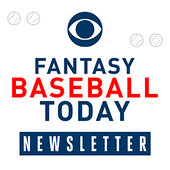
Fantasy Baseball Today Newsletter
Your Cheat Code To Fantasy Baseball
You're destined to gain an edge over your friends with advice from the award-winning FBT crew.
Thanks for signing up!
Keep an eye on your inbox.
Sorry!
There was an error processing your subscription.
5. Which pitcher is most likely to experience negative regression rest of season?
- Scott: You can't make me believe in Matthew Boyd. He finally allowed five runs (albeit only four of them earned) Sunday to bring his ERA up to 2.45, but the crooked line is coming that blows it up from there. His new pitch mix has yielded a softer contact rate so far, making up for the lack of strikeouts, but that's a trait I don't put much stock into until a pitcher has a firm track record with it. His fly-ball rate remains as extreme as it was in his slider spamming days, and that he's allowed only two home runs with it to this point simply does not compute. His 4.69 xFIP pretty much tells the story.
- Chris: It's so hard to answer this question, because the most likely answer is someone like John Means. However, I think he's likely to still be something like a mid-3.00s ERA pitcher, and since nobody really expects him to be a 1.21 ERA pitcher, am I really telling you anything all that useful? So, I'll pivot to Huascar Ynoa, one of the early-season breakouts I'm not buying. His stuff is very good and he'll keep getting plenty of strikeouts, but Ynoa is going to have trouble keeping the ball in the yard given how hard he gets hit when he does give up contact, and I think that's more likely to lead to an ERA near 4.00 than below 3.00.
- Frank: I'll go with Taijuan Walker, who currently has a 2.20 ERA despite a 4.12 xFIP and a 4.42 SIERA. His velocity is up this year, which is nice, but he doesn't get enough strikeouts to mitigate his high walk numbers. He's also allowed just one home run this season, which is going to change with the weather heating up across baseball. If you could sell-high on Walker right now, I think you should.
















